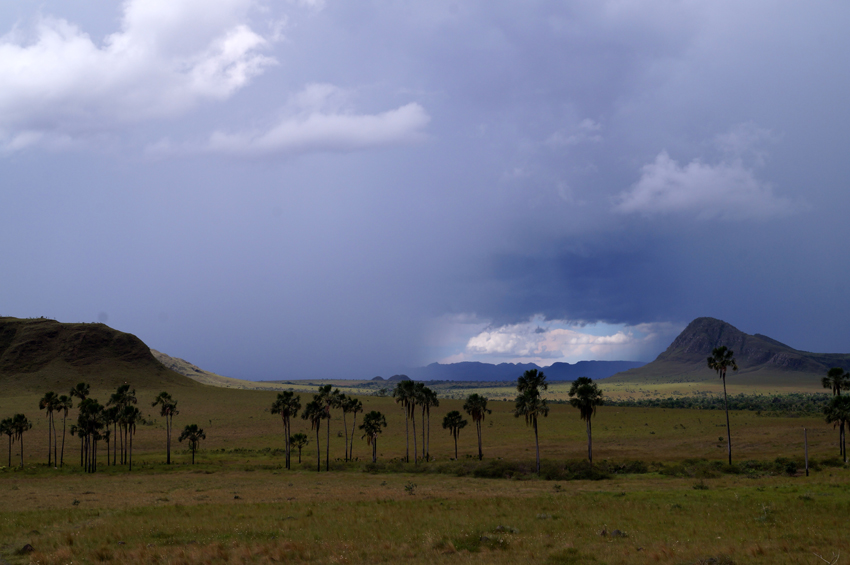World Heritage as an indicator of protected areas’ success: the case of Latin America and the Caribbean
As the global conservation community rallies around a common ambition – to assess the level of achievement of Aichi Targets and define the post-2020 agenda for biodiversity – the IUCN World Heritage Outlook emerges as a useful indicator of the effectiveness of protected areas. The third Latin American and Caribbean Protected Areas Congress (CAPLAC III), which recently concluded in Lima, Peru, provided a springboard for measurement at the regional level.

Cerrado Protected Areas: Chapada dos Veadeiros and Emas National Parks, Brazil. The site's conservation outlook improved from "significant concern" in 2014, to "good with some concerns" in 2017.
Photo: IUCN / Elena Osipova
The Lima Declaration adopted at CAPLAC III welcomed the positive results from the region’s 33 countries in reaching important elements of Aichi Target 11 – increased coverage of protected areas, and better assessment of their management effectiveness. The region now protected 23.6% of land and 18.1% of sea, and management effectiveness has been assessed in 40.7% of protected areas in the last decade. But how do we measure the success of protected areas overall? The IUCN World Heritage Outlook provides an indicator for this.
Given their global recognition and significance, natural World Heritage sites have an extremely important leadership role to play within the wider context of protected areas. They provide crucial insight into the successes and challenges on the frontlines of conservation. Monitoring World Heritage sites is therefore a crucial barometer of the effectiveness of protected areas.
Launched in 2014, with a first update in 2017 and a second one due in 2020, the IUCN World Heritage Outlook is IUCN’s flagship product on natural World Heritage. It assesses and tracks the conservation prospects of all listed natural sites over time based on an assessment of values, threats, and protected and management.
The IUCN World Heritage Outlook 2, published in 2017, analysed assessment results for eight regions, including Mesoamerica and the Caribbean, and South America. The latter region counted 23 World Heritage sites in 2017, covering together almost 33 million hectares of land and sea, while the former had 20 sites covering 7.5 million hectares.
These two regions of the world are of crucial for biodiversity. Of the 43 World Heritage sites listed for their natural values up to 2017, the vast majority (37) earn their status – in part or fully – thanks to their significance for the conservation of globally important species or ecosystems processes, or both. However, according to the IUCN World Heritage Outlook, these values are more threatened than those linked to other types of natural World Heritage sites, namely geological ones and those linked to exceptional natural beauty.
The IUCN World Heritage Outlook also shows that, between 2014 and 2017, threats to these values have continued to increase, while at the same time protection and management effectiveness has decreased in natural World Heritage sites overall. In Latin America and the Caribbean, protection and management was assessed as being of significant concern in nearly three-quarters of the sites. This suggests we must refocus efforts on management to address main challenges and improve the effectiveness of conservation in these iconic sites. This is particularly the case in Mesoamerica and the Caribbean, and South America.
In both these regions, climate change was found to be the number-one threat to natural World Heritage sites. Together with Oceania, Mesoamerica and the Caribbean is the region with the highest number of sites where climate change was assessed as a high or very high threat (11). The second biggest threat is fishing, followed by invasive species. In South America, the most widespread threats after climate change were farming and grazing, followed by tourism. At the global level, invasive species were the most significant threat, followed closely by climate change – the fastest growing threat in three years.
The IUCN World Heritage Outlook provides both an overall picture on the effectiveness of conservation efforts in protecting the world’s most iconic natural areas, at global and regional levels, and detailed assessments of site-specific issues. Natural World Heritage sites, which are granted unique international recognition, should demonstrate leadership in protected areas. Their conservation, and our collective ability to ensure they have a bright outlook, is thus a litmus test for the success of protected areas more broadly.
Continuing to assess natural World Heritage through IUCN’s Outlook is all the more relevant at a time when discussions around the post-2020 agenda are gathering pace. IUCN has now launched the preparation of the IUCN World Heritage Outlook 3, which will be presented at the UN Biodiversity Conference in late 2020. IUCN has called on its members, commission experts, and all interested partners to participate in this process by providing information and engaging in review of site assessments. The information collected through this tool to date can serve as a useful indicator for informing the international community on priorities for biodiversity after 2020.



